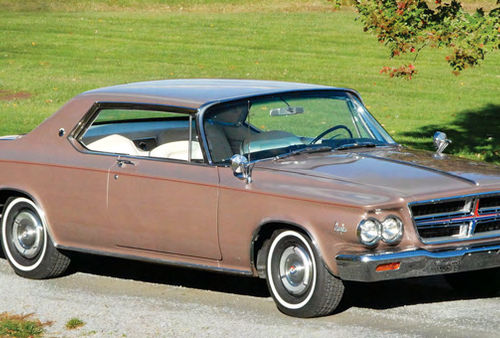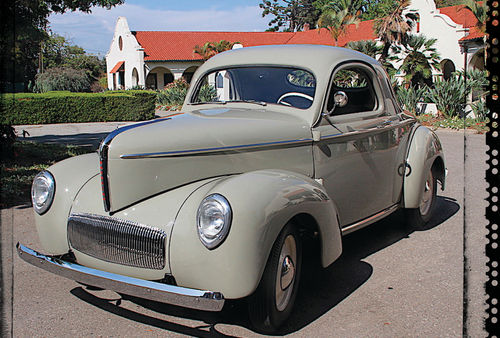1958 Ford Thunderbird
There was time, only a president or two ago: when the two seater Thunderbirds from 1955, 56 and ’57 owned all the respect and admiration that was given to the still-popular marque. The four-passenger versions were scorned as if they were the epitome of hell on wheels. Many still remorse the day that Ford traded two seats for four. As the years passed, the early “Birds soared in popularity while all others were mired in obscurity.
How times have changed.
No longer the lumbering, unwanted relation to the sleek and classy original T-Birds, the first of the four-passenger T-Birds has become the Tony Bennett of collectible automobiles. There’s a new generation that has discovered this act has panache.
In case the fact has been lost in the unused corners of some brains, it is a fact that the 1958 Thunderbirds were a huge success in a year that is well acquainted with dismal failures. New car showrooms were not the beehive of activity that had been the norm throughout the fabulous year of 1957.

In what would prove to be a down year, the bigger, more powerful, more status-enhancing Thunderbird was a hit. It was now the personal luxury car with room for the family.
Although the original T-Bird has always been considered a sports car, it really never was. It was a status car and a very successful one. It wasn’t designed to compete on the track with the likes of Corvette and the European sports cars that had prompted American manufacturers to build two-seaters in the first place. From the beginning, this was an image car that played the part to perfection for both Ford and for the folks who parked one in their driveway.
The decision to grow the T-bird was not done without some amount of consternation. Discussions regarding whether the car should be offered as both a two- and four seater as well as whether it should be continued at all were being hammered out in Dearborn.

At one point, there was a plan for both two and four-passenger models to be on the streets in ’58. But when the company focused squarely on the bottom line, the two-seater ’Bird just wasn’t bringing in the revenue; image enhancement be damned. When the executives at Ford decided there was more money to be made in the suburbs than on the race track, it became inevitable that the T-Bird would grow to be something bigger and more practical.
Although even the early T’Birds out- = which was the highest of the two sold Corvette by a handy margin, seat T-Birds. Motor Trend recognized
when the car added two additional nized that there was something spehere Was someth Ng seats in 1958, the sales differential cial going on at Ford and named essentially shows Ford overpowering the Thunderbird Car of the Year. SpeCl go ng on at Ford oe in the race to aes Ue : | behind the wheel of their new im- omparisons between the ’58 age-making automobiles. and the earlier Thunderbirds and named Thunderb : It weet until late in the model are never-ending even though the year—Feb. 13, 1958—that the re- differences are a5 apparent as the Car of the Year designed Thunderbird became horseradish ice cream. Nothavailable. Sales immediately went ing subtle here. through the roof and before the The new ’Bird was two feet dust settled 37,892 had been sold. longer and 600 pounds heavier than Sales were nearly double 1957, _ its predecessor. Unit body construction was used for the first time on a Ford nameplate (Lincoln already had implemented this method).
The single-unit concept incorporated body, frame, front and rear fenders, bulkhead, dash and floor into one piece of steel. That not only provided structural strength but had the added benefit of improving handling. Thunderbirds were built at the Lincoln-Mercury factory in Wixom, Michigan, alongside the Lincoln Continental Mark IIIs. Both vehicles were considered low-volume luxury cars, but pro | HISTORICAL
VEMECE
eet
The ’58 T-bird was noticeably bigger than its predecessor. The extra length and weight was moved by a 300 horsepower, 352 cubic inch V-8.
duction was never interrupted despite the lagging economy that was practically saturated with cars. The unit body design presented a number of challenges and opportunities in the redesign of the Thunderbird.
One innovation was the inclusion of a “torque box” that was designed to not only absorb road stress but allow the body to be restyled every year with minimum changes to the frame. Unit body design, with its flat underbelly, required a redesign of the exhaust system, necessitating dual, reverse flow mufflers located behind each rear wheel. A coil spring suspension proved to be a mistake since the resulting bouncy ride was undesirable. Leaf springs replaced the coils in the 1959 models.
The flat underside also resulted in a taller driveshaft tunnel. To overcome this intrusion into the interior, a center console was designed to house the radio speaker, window switches and heater controls.

In many respects the Thunderbird maintained the body styling consistent with other cars in the Ford line. The hardtop was similar in appearance to the Skyliner retractable hardtop that was an engineering marvel. Out front a huge front bumper surrounded a honeycomb style grille that was shared by the other Fords. On the T-Bird the honeycomb pattern was carried through to the rear of the car where it surrounded four large taillight pods.
Although few things would change when the 1959 T-Birds were designed, the honeycomb grille design was abandoned. Along with the other Ford models, a sweepspear design was incorporated into the profile of the car.

The original 312-cubic-inch Thunderbird Special engine was replaced by a 300 horsepower V-8 that displaced 352 cubic inches and was fed by a four-barrel Holley carburetor. Improvements over the old engine included a higher compression ratio, a better manifold and better valve design.
Out front a huge bumper surrounded a honeycomb grille that was shared by other Fords.
There were bigger, more powerful engines in the Chrysler 300-D (345 bhp) and the Cadillac 62 (310 bhp), but the bird was lighter than either of those cars. The big V-8 was strikingly similar to the small Edsel engine of that year; one difference being the use of hydraulic lifters. When pushed, it could crank out 395 Ib.-ft. of torque. The engine also served as a popular option in the Fairlaine 500 and station wagon models.
Motor Trend performance tests on early 1958 T-birds showed 0-60 times of 13.5 seconds, however, later tests demonstrated considerable improvements to 9.9 seconds.

The ’58 Thunderbird was not available as a convertible until late in the production year. The delay in get from restoring Perfection
GENERAL ‘
Front engine, rear-wheel-drive convertible | Base price $3914 ENGINE
Type Ohv V-8 Bore x stroke 4.00 in. x 3.50 in. Displacement 392 CU. In. Compression ratio 10.2:1 Carburetor Single four-barrel POW co 300 bhp at 4600 rpm Torque 395 Ib.-ft. at 2800 rpm DRIVETRAIN
Transmission . 3-speed automatic Final drive ratio (:1) 2.69
SUSPENSION & BRAKES
Front Independent, coil springs Rear Live axle, coil springs Brakes (f/r) _ Drum/drum, power assist MEASUREMENTS
Wheelbase _ 113 in. Length 3 oe 200.4 ih Width 77 in. Meighh n= ee Seat Weight 3903 Ib. Pe SiR 8.00 x 14 in.
CALCULATED DATA
Weight per bhp ARO PERFORMANCE i 0-60 mph 9.9 sec. 40-60 mph | bs OO Se:
SOURCE: Motor Trend
its introduction was attributed to problems with the operating mechanism for the top. As it was, the top
Ay
‘ ean ee
stments that
required manual adju : were not rated high on the conve— | ae: 2 B nience scale. For 1959 the top was made fully automatic.
With only a couple of months before the introduction of the 1959s, Ford managed to sell 2134
= : convertible Thunderbirds. The next eset: wee year that number would climb to The convertible version of the 58 T-bird was late in arriving and the top operation was more than 10,000, which means the not fully automatic. Only 2134 were produced making them among the rarest of birds. ‘58 Bird is flying in rare air. &
Sana a eeeemianemanane ae
Visiting T-Bird Paradise
Michael Ogletree’s yard is a vii of Thunderbird heaven on earth. That is, if your vision of Thunderbird heaven is populated with the early four-seat versions of the ever-popular Ford. For those who know Thunderbirds, these are known as the Square Birds and Ogletree has a half-dozen waiting in line at his pearly gates for a chance of entering. They all have a purpose. They all have a life ahead of them.

Ogletree has been. restoring Square Birds since 1983 and his work has been well received. His restorations have garnered major international awards including a Best of Show in the 1993 All Thunderbird Show, which was taken home with his rose pink convertible that graces these pages.
He bought this 58 five years ago even though the car was without a powertrain or an interior. Because this is one of the 2134 convertibles produced in 1958, and only 62 are known to exist, he had no intention of passing it up. During the restoration process, he installed the engine and transmission, the new interior, the glass and the convertible top. He contracted the body work and paint, items that set him back about $12,000.
According to Ogletree, a restorable 1958 convertible is valued in the $5000 to $6000 range, but a showroom condition example might bring $27,000 to $35,000. He believes his restorations are worth up to $50,000.

“The Square Birds were once considered the worst T-birds of all time,” he says. “That general perception has changed quite a bit since those days;.
















